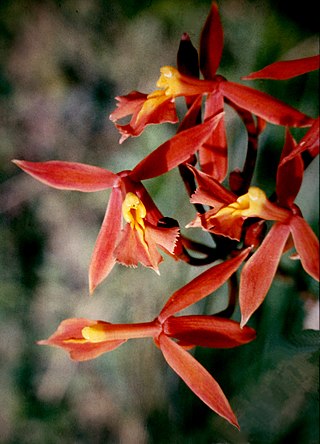
Asparagales is an order of plants in modern classification systems such as the Angiosperm Phylogeny Group (APG) and the Angiosperm Phylogeny Web. The order takes its name from the type family Asparagaceae and is placed in the monocots amongst the lilioid monocots. The order has only recently been recognized in classification systems. It was first put forward by Huber in 1977 and later taken up in the Dahlgren system of 1985 and then the APG in 1998, 2003 and 2009. Before this, many of its families were assigned to the old order Liliales, a very large order containing almost all monocots with colorful tepals and lacking starch in their endosperm. DNA sequence analysis indicated that many of the taxa previously included in Liliales should actually be redistributed over three orders, Liliales, Asparagales, and Dioscoreales. The boundaries of the Asparagales and of its families have undergone a series of changes in recent years; future research may lead to further changes and ultimately greater stability. In the APG circumscription, Asparagales is the largest order of monocots with 14 families, 1,122 genera, and about 36,000 species.

The Pleurothallidinae are a neotropical subtribe of plants of the orchid family (Orchidaceae) including 29 genera in more than 4000 species.

Cypripedioideae is a subfamily of orchids commonly known as lady's slipper orchids, lady slipper orchids or slipper orchids. Cypripedioideae includes the genera Cypripedium, Mexipedium, Paphiopedilum, Phragmipedium and Selenipedium. They are characterised by the slipper-shaped pouches of the flowers – the pouch traps insects so they are forced to climb up past the staminode, behind which they collect or deposit pollinia, thus fertilizing the flower. There are approximately 165 species in the subfamily.

The taxonomy of the Orchidaceae (orchid family) has evolved slowly during the last 250 years, starting with Carl Linnaeus who in 1753 recognized eight genera. De Jussieu recognized the Orchidaceae as a separate family in his Genera Plantarum in 1789. Olof Swartz recognized 25 genera in 1800. Louis Claude Richard provided us in 1817 with the descriptive terminology of the orchids. (See External links below). The next step was taken in 1830-1840 by John Lindley, who recognized four subfamilies. He is generally recognized as the father of orchid taxonomy. The next important step was taken by George Bentham with a new classification, recognizing subtribes for the first time. This classification was first presented in a paper that Bentham read to the Royal Society in 1881. Then it was published in 1883 in the final volume of Genera Plantarum. The next great contributors were Pfitzer (1887), Schlechter (1926), Mansfeld (1937), Dressler and Dodson (1960), Garay (1960, 1972), Vermeulen (1966), again Dressler (1981). and Burns-Balogh and Funk (1986). Dressler's 1993 book had considerable influence on later work.

The Orchidoideae, or the orchidoid orchids, are a subfamily of the orchid family (Orchidaceae) that contains around 3630 species. Species typically have a single (monandrous), fertile anther which is erect and basitonic.

The Oncidiinae is a subtribe within the Orchidaceae that consists of a number of genera that are closely related.

Epidendroideae is a subfamily of plants in the orchid family, Orchidaceae. Epidendroideae is larger than all the other orchid subfamilies together, comprising more than 15,000 species in 576 genera. Most epidendroid orchids are tropical epiphytes, typically with pseudobulbs. There are, however, some terrestrials such as Epipactis and even a few myco-heterotrophs, which are parasitic upon mycorrhizal fungi.

Vanilloideae is one of the subfamilies of orchids belonging to the large family Orchidaceae.

Apostasia, commonly known as grass orchids, is a genus of eight species of primitive orchids in the family Orchidaceae. They are terrestrial, evergreen, grass-like plants, barely recognisable as orchids and are distributed in humid areas of the Himalayan region, China, India, Sri Lanka, Southeast Asia, New Guinea, and Queensland. They have many narrow leaves and small yellow or white, non-resupinate, star-like flowers usually arranged on a branched flowering stem.

Neuwiedia is a genus of primitive terrestrial orchids, comprising 9 species native to China, Southeast Asia and certain Pacific Islands.

Pogoniopsis is a genus of orchids. It contains two known species, both endemic to Brazil. It was previously included in the subfamily Vanilloideae, but is now placed in the tribe Triphoreae of the subfamily Epidendroideae.

Arethuseae is a mid-sized tribe of orchids in the subfamily Epidendroideae. This tribe was initially categorized by John Lindley in 1840. Its largest subtribes are Arethusinae and Coelogyninae.
Nothostele is a genus of flowering plants from the orchid family, Orchidaceae. It contains two known species, both endemic to Brazil.

The Eriinae form a subtribe of Podochileae, a tribe of the orchid family (Orchidaceae). The name is derived from the genus Eria.

Dendrobieae is a tribe in the subfamily Epidendroideae, in the family Orchidaceae. The Dendrobieae are mostly tropical, epiphytic orchids which contain pseudobulbs.

Orchideae is a tribe of orchids in the subfamily Orchidoideae. Historically, it was divided into 2 subtribes, Orchidinae and Habenariinae. The subtribe Orchidinae alone contains about 1,800 species. However, although some phylogenetic studies have established the monophyly of the subtribes, the generic boundaries are unclear, with many genera as traditionally circumscribed being paraphyletic or even polyphyletic. Species of genera such as Habenaria and Platanthera have been placed into both subtribes. A 2017 molecular phylogenetic study found that both subtribes did form clades, but did not formally recognize Habenariinae, because of missing genera and uncertainty over generic boundaries. The Asian species of Orchideae, in particular, have been subject to repeated changes of generic placement from 2012 onwards.

Diseae is an orchid tribe in the subfamily Orchidoideae. It was recognized in Genera Orchidacearum volume 2, which was published in 2001. It consisted of 12 genera in five subtribes. In molecular phylogenetic studies that were published after 1999, it was shown that Diseae is paraphyletic over the tribe Orchideae. In a classification of orchids that was published in 2015, Diseae was not recognized, but was instead placed in synonymy under Orchideae.

Calypsoinae is an orchid subtribe in the tribe Epidendreae of subfamily Epidendroideae. It has previously been recognized as tribe Calypsoeae in the subfamily Epidendroideae.

Gastrodieae is an orchid tribe in the subfamily Epidendroideae.

Neottieae is an orchid tribe in the subfamily Epidendroideae. It contains six genera and over 200 species distributed mainly in temperate and subtropical zones of the northern hemisphere. All its members are terrestrial plants, hinting at an early branching with Epidendroideae which is largely an epiphytic group. Neottieae is likely to be the result of a single temperate radiation of epidendroids, although it appears that some lineages in this tribe have crept back into the tropics.




















